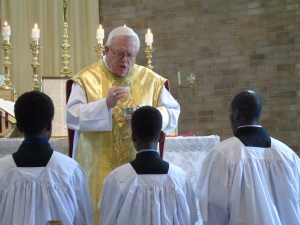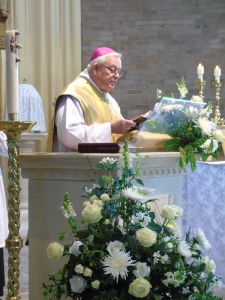Bedford
May 24, 2018
Great news! Two extra sung Masses a month, with music performed by Matthew Schellhorn.
From the FSSP site:
https://fssp.co.uk/increasing-the-number-of-sung-masses-at-bedford/
We are very pleased to announce that we are increasing the number of Sung Masses at Bedford!
You might recall that a few weeks ago Matthew Schellhorn kindly sang and played the organ at our 8.30 Mass. The FSSP is pleased to announce that he has accepted the invitation to sing and play on two Sundays a month outside of July and August.
Matthew has been involved in Sacred Music for all of his life. From
2013–15 he was the first Director of Music for the International
Federation Una Voce, during which time he served as Moderator of the Sacred Music Sub-Committee. More recently, between 2017–18 he was Associate Director of Music at St Dominic’s Priory, Haverstock Hill, and continues as Director of Music for the celebrations according to the 1962 Missal at St Anne Line, South Woodford. Since 2015 he has been Director of Music for London of the Latin Mass Society, where in that capacity and with his professional group Cantus Magnus he provides the music for the monthly Masses organised by Juventutem London and for the Sacred Triduum held at St Mary Moorfields, London. His other work includes giving recitals and recording as a pianist, examining for ABRSM, and teaching in Cambridge where is a member of the Faculty of Music. He currently lives in London with his wife, Benna, and their two sons, Ferdinand and Caspar.
Matthew’s involvement with us will be to play the organ and sing on the third Sunday of each month plus one additional Sunday. The dates of those additional Sundays will be chosen with an eye to important celebrations such as the feast of Christ the King and the annual November Requiem for war dead. Our schola, led by Katherine Smith, will continue to sing on First Sundays.
As we look forward to welcoming Matthew, our thanks goes to Katherine and our schola for their ongoing commitment and hard work. After the week before last, they can now pride themselves in saying that they have sung a Pontifical Mass!
Over time Matthew hopes to get to know Christ the King’s parishioners and explore how his musical contribution to the life of our apostolate in Bedford can organically grow and develop.
by fsspuk
May 23, 2018
We are very pleased to announce that we are increasing the number of Sung Masses at Bedford! A few weeks ago Matthew Schellhorn kindly sang and played the organ at our 8.30 Mass. The FSSP is pleased to announce that he has accepted the invitation to sing and play on two Sundays a month outside of July and August.
Matthew has been involved in Sacred Music for all of his life. From 2013–15 he was the first Director of Music for the International Federation Una Voce, during which time he served as Moderator of the Sacred Music Sub-Committee. More recently, between 2017–18 he was Associate Director of Music at St Dominic’s Priory, Haverstock Hill, and continues as Director of Music for the celebrations according to the 1962 Missal at St Anne Line, South Woodford. Since 2015 he has been Director of Music for London of the Latin Mass Society, where in that capacity and with his professional group Cantus Magnus he provides the music for the monthly Masses organised by Juventutem London and for the Sacred Triduum held at St Mary Moorfields, London. His other work includes giving recitals and recording as a pianist, examining for ABRSM, and teaching in Cambridge where is a member of the Faculty of Music. He currently lives in London with his wife, Benna, and their two sons, Ferdinand and Caspar.
Matthew’s involvement with us will be to play the organ and sing on the third Sunday of each month plus one additional Sunday. The dates of those additional Sundays will be chosen with an eye to important celebrations such as the feast of Christ the King and the annual November Requiem for war dead. Our schola, led by Katherine Smith, will continue to sing on First Sundays.
As we look forward to welcoming Matthew, our thanks goes to Katherine and our schola for their ongoing commitment and hard work. After the week before last, they can now pride themselves in saying that they have sung a Pontifical Mass!
Over time Matthew hopes to get to know Christ the King’s parishioners and explore how his musical contribution to the life of our apostolate in Bedford can organically grow and develop.
 October 2015: Matthew Schellhorn is introduced to The Most Reverend Archbishop Pozzo (then Secretary of the Pontifical Commission Ecclesia Dei). Photograph by Joseph Shaw.
October 2015: Matthew Schellhorn is introduced to The Most Reverend Archbishop Pozzo (then Secretary of the Pontifical Commission Ecclesia Dei). Photograph by Joseph Shaw.
by Fr JM
May 21, 2018
Pentecost Sunday saw a record attendance – 82 people came to the Old Rite Mass at 8:30am. This represents a 400% increase in less than three short years, showing the significant demand for Mass in the Extraordinary Form. We also had a very gracious letter from Bishop Doyle, where he said “It was a joy to celebrate the Masses, including the Mass in the Extraordinary Form,and to meet so many members of the parish.”
We are truly grateful for all Bishop Doyle’s support and for that of Fr. Patrick Hutton and of course all the priests of the Fraternity of St. Peter.
Watch this space; another very exciting development will be announced shortly!

by fsspuk
May 18, 2018

Young Adults (18 to 35 years-old) are invited to join us for a social evening this Saturday, the Vigil of Pentecost. We will meet at 5pm in the parish room at the eastern end of the Church of Christ the King in Bedford (MK42 0SP). After a talk with Q & A entitled “The Blessed Trinity: Principle of Everything“, we will head to a local venue for dinner and drinks. Outline for the talk:
– Biblical Revelation of the Blessed Trinity
– Patristic & Scholastic theology: St Augustine & St Thomas
– Blessed Trinity and the person / marriage / life
– Blessed Trinity contra divorce / abortion / contraception
– Our final purpose, the beatific vision, is beholding the Blessed Trinity
As tomorrow’s weather is expected to be excellent, it may be we change venue for the talk to the north bank of the River Great Ouse–at a spot opposite the Longholme Boathouse, on the green strip between Russell Park and the river. There is free parking along The Embankment. Please email us here if you plan to join us, or else simply turn up.

by Fr JM
May 15, 2018
 During his pastoral visit to Christ the King, Bedford, on the weekend of 12 – 13 May, Bishop Peter Doyle of Northampton was called upon to go the extra mile. He was due to preach at the Latin Mass, but at the last minute, due to unforeseen circumstances, he not only gave the homily, but celebrated the Mass as well.
During his pastoral visit to Christ the King, Bedford, on the weekend of 12 – 13 May, Bishop Peter Doyle of Northampton was called upon to go the extra mile. He was due to preach at the Latin Mass, but at the last minute, due to unforeseen circumstances, he not only gave the homily, but celebrated the Mass as well.
He told us afterwards that it was the first time he had celebrated in the Extraordinary Form. Bishop Doyle’s Latin proved to be excellent, and with guidance from Fr Goddard, all went smoothly and the Holy Sacrifice of the Mass was duly and properly offered.
We are very grateful to both Bishop Doyle and Fr Goddard for adapting so readily to the situation and so enabling the Mass to take place.
by fsspuk
May 10, 2018
On this Feast of the Ascension of the Lord, the Priestly Fraternity of St Peter is pleased to introduce the Summer issue of our quarterly magazine Dowry (Summer 2018, No38).
SPECIAL ISSUE ON HOLY MATRIMONY
The layout is designed to be looked at as a double page: make sure to select this display on your pdf reader.
Click on the cover of the magazine to open the 4.2Mo pdf file.

In this issue:
Editorial: Alfie’s Death Made Us All Orphans
R.I.P. – Dolores O’Riordan of The Cranberries
The Marriage of the Virgin by Raphael
Humanae Vitae and the Crisis of Faith
The Ends of Marriage
My Name Is Bond, Marriage Bond
Forthcoming Events
Pictures of Holy Week
Support our apostolate
Please share this link with your friends: this is a simple way of spreading good news and doctrine.
by Fr AM
May 8, 2018

We have a fantastic evening planned for Friday 6 July under the auspices of the Social Committee at Christ the King. Mick Wooldridge, the husband of one of our congregation, is a barn dance caller and has very kindly offered his services free of charge. Mick also plays the saxophone and will be playing between dances while we catch our breath!
Bring your own food, but there will be a bar, raffle and barn dance costume fancy dress competition. All for a very reasonable £5 for adults and £3 for children. After expenses, the proceeds will be divided equally between the parish and the FSSP. Mary Wooldridge has tickets available in the hall on Sunday mornings. The parish contact is Sue Anstead, 01234 965497.
Come and bring your friends!
by fsspuk
May 4, 2018
‘Ego Eimi – It is I’ (John 6:51)
A series of conferences on the Most Holy Eucharist
By Fr Armand de Malleray, FSSP, Rector of St Mary’s Shrine
Given live at St Mary’s Shrine Church, Buttermarket Street, Warrington WA1 2NS, England
In preparation for the National Eucharistic Congress in Liverpool (7-9 Sept. 2018)
Free for all. All welcome to St Mary’s.

Each 40-min conference starts at 7:00pm GMT and will be broadcasted on LiveMass.net
• Monday 11 June, 7:00pm: Transubstantiation: how the Body, Blood, Soul and Divinity of Christ occur under the externals of bread and wine
• Tuesday 12 June, 7:00pm: Concomitance: how Christ’s Blood also is in the Host, and His Body also in the Chalice
• Wednesday 13 June, 7:00pm: Fragments: why each of them is Christ, and how to treasure them
• Thursday 14 June, 7:00pm: Gradation: how God’s presence is supreme in the Holy Eucharist
Low Mass will be offered each of the four evenings at 6:00pm, before each conference.
by Fr AM
One of our parishioners, Eric Caudle, took some wonderful photos of the Mass last Sunday.
Like what you see? It happens every week, and it’s even better in person!






by fsspuk
May 3, 2018
Reminder: First Saturday Fatima devotions & Family Catechism Day from 10am this Saturday.
Venue
Christ the King Roman Catholic Church
Harrowden Road, Bedford MK42 OSP
First Saturdays–All welcome
3 February, 3 March, 7 April, 5 May, 2 June 2018
Programme
10am Fatima Devotions (Rosary & meditation, Confessions)
11am Holy Mass
12noon Lunch (bring packed lunch)
12:30pm Catechism (for under-8s)
1pm Catechism (for under-16s)
1:45pm Catholicism in 2018 (presentation for adults)
2:30pm Altar server training / Gregorian Chant practice

by Fr JM














